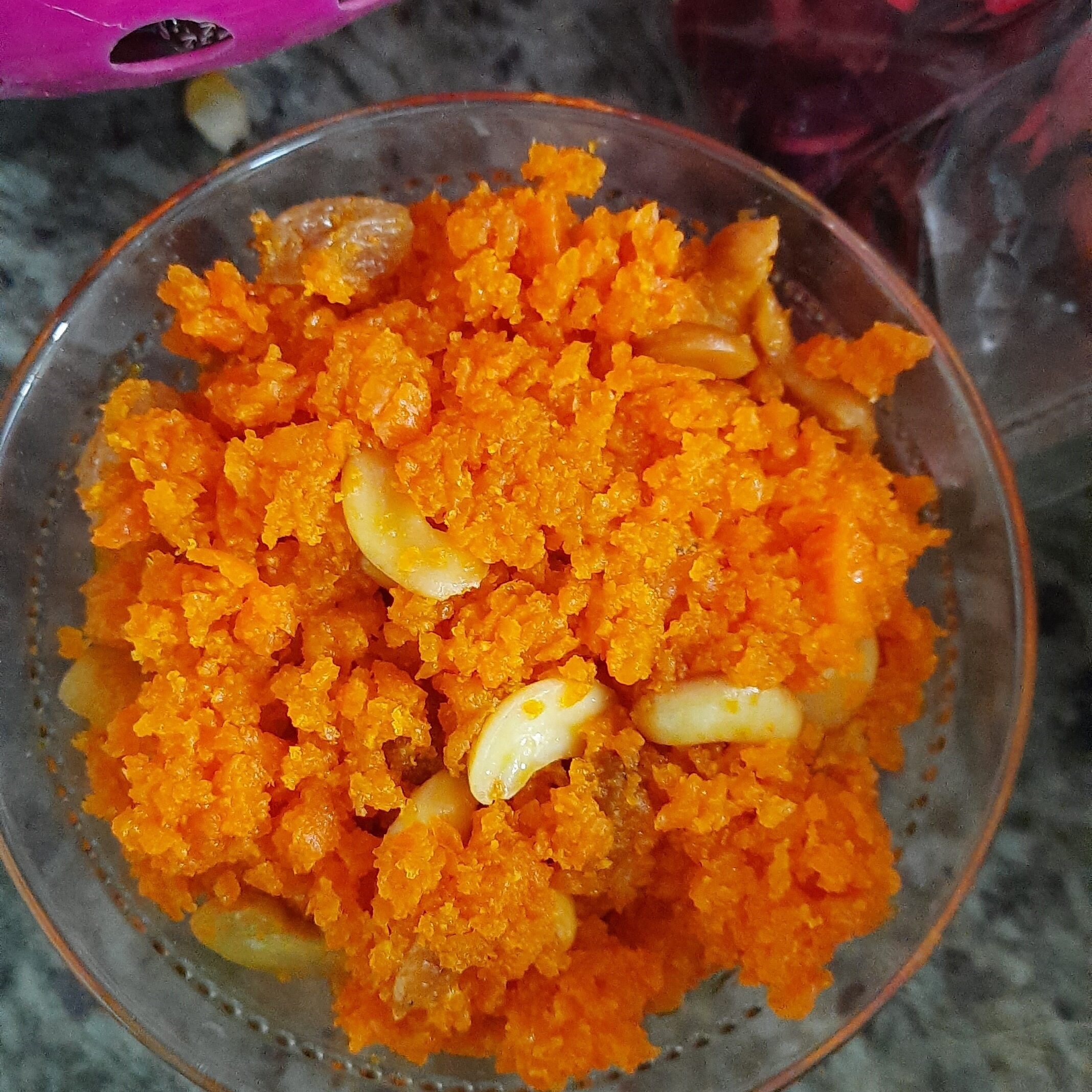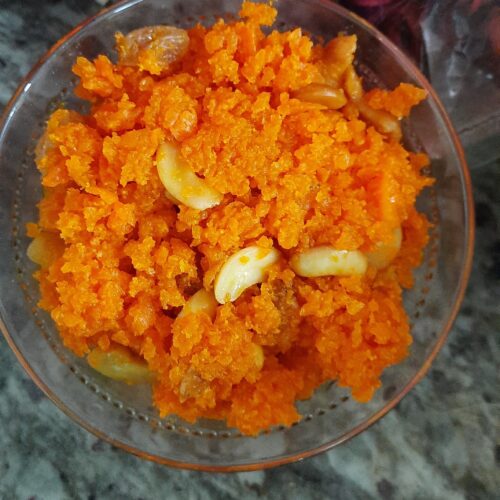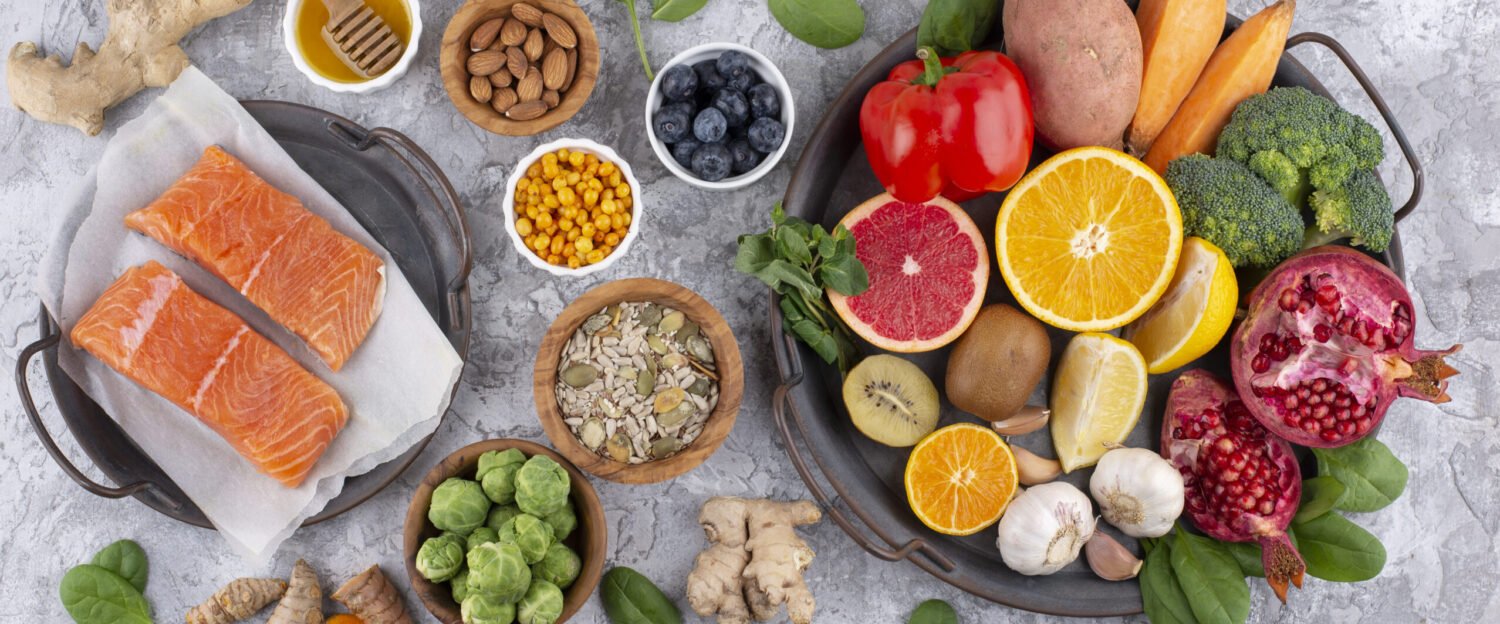
Table of Contents
What is Gajar ka halwa:
Carrot Halwa, also known as Gajar Ka Halwa, is a popular Indian dessert made in special occasions and events. It is one of my favorite dessert as it is healthy option and can be prepared at home easily like restaurant style. Gajar ka halwa can be made in different styles like frying on pan and in pressure cooker.
What are the ingredients of Carrot halwa?
- Carrots: Fresh Carrots are grated or finely chopped to form the base of the halwa. Carrots are the star ingredient of this dessert.
- Milk: Whole milk is commonly used to cook the carrots. It helps in softening the carrots and creating a creamy texture as it reduces during the cooking process.
- Sugar: Granulated sugar is added to sweeten the halwa according to taste. The amount of sugar used can vary depending on personal preference and the sweetness of the carrots.
- Ghee (Clarified Butter): Ghee is used to sauté the grated carrots and enhance the richness and flavor of the halwa. It adds a distinct aroma and richness to the dish.
- Nuts: Almonds, pistachios, and cashews are often used for garnishing halwa. Sometimes, they are also added during the cooking process to impart a nutty flavor and provide a crunchy texture.
- Cardamom: Ground cardamom powder is added to the halwa for flavoring. It lends a subtle yet distinctive aroma and taste to the dessert.
- Optional Ingredients: Halwa may include additional ingredients such as Saffron strands, Condensed milk.
Is Carrot Halwa Healthy?
Gajar ka Halwa is a good option in desserts and it is healthy of course if eaten in moderate amount. The richness of the Ghee, the sweetness of the Carrots, and the creaminess of the Milk combine to create a delightful dessert that is enjoyed by people of all ages. Flavors extracted from cardamom and garnished with Nuts.
Preparation Tips:
- Fresh and Finely grated Carrots: Select fresh, tender carrots for the best flavor and texture. Carrots that are sweet and not overly mature work best for halwa.
- Saffron Strands: Use Saffron for rich color and flavor enhancement, raisins for added sweetness or condensed milk to intensify the creaminess.
- Use Whole Milk: Whole milk adds richness and creaminess to the halwa. Avoid using skim or low-fat milk as they won’t provide the same creamy texture.
- Control the Sweetness: Taste the carrots before adding sugar, as the sweetness can vary. Adjust the amount of sugar accordingly. Remember, you can always add more sugar if needed, but it’s challenging to reduce the sweetness once it’s added.
- Be Generous with Ghee: Ghee adds flavor and richness to the halwa. Don’t skimp on it, but be mindful not to overdo it either. A moderate amount of ghee is usually sufficient to enhance the taste.
- Cook on Low Heat: Cook the grated carrots in milk on low to medium heat. This allows the carrots to cook slowly, absorb the flavors, and become tender without burning.
- Stir Frequently: Stir the halwa frequently to prevent it from sticking to the bottom of the pan and burning. This is especially important when the mixture thickens.
- Add Cardamom for Aroma: Use freshly ground cardamom for the best results.
- Patience is Key: Making carrot halwa takes time and patience. Allow the carrots to cook slowly and absorb the flavors for the best results. The end result is worth.
Dessert Recipes:
- Gulab Jamun
- Rava Kesari
- Vermicelli Kheer
- Double ka Meetha
Gajar ka Halwa Recipe Card:
Here’s a basic recipe for making Gajar ka halwa:

Carrot Halwa Recipe
Equipment
- Kadai
Ingredients
- 2 cups carrots peeled and grated
- 1/2 cup whole milk
- 1/2 cup sugar adjust to taste
- 1/4 cup ghee clarified butter
- 1/4 cup chopped nuts almonds, cashews, pistachios, raisins
- 1 teaspoon cardamom powder
- A pinch of saffron strands optional, for color and flavor
Instructions
- Grate Carrots: Peel and grate the carrots using a fine grater. You can also use a food processor for this step.
- Cook Carrots: In a heavy-bottomed pan, heat 2 tablespoons of ghee. Add the grated carrots and sauté them on medium heat for about 8-10 minutes until they start to soften.
- Add Milk: Pour in the milk and simmer the carrots in the milk until the milk is mostly absorbed, stirring occasionally. This can take around 20-25 minutes.
- Add Sugar: Add sugar to the carrots and continue cooking, stirring frequently, until the mixture thickens and the sugar is fully dissolved. This might take another 15-20 minutes.
- Add Ghee: Add the remaining ghee and continue to cook the mixture. The halwa will start to leave the sides of the pan, and the color will deepen.
- Flavor with Cardamom: Add cardamom powder and mix well. If using saffron, dissolve it in a tablespoon of warm milk and add it to the halwa for a beautiful color and aroma.
- Add Nuts: Stir in the chopped nuts and cook for an additional 2-3 minutes. Save some nuts for garnishing.
- Garnish and Serve: Garnish with more nuts and raisins, if desired. Halwa can be served warm or cold.
Nutrition:
The nutritional content of Gajar ka halwa can vary based on factors like portion size, the ratio of ingredients used, and any additional ingredients like nuts or saffron. However, here’s a general overview of the nutritional components of gajar ka halwa based on common ingredients:
- Calories: Approximately 150-200 calories per serving.
- Carbohydrates: Around 20-30 grams, primarily from carrots and added sugar.
- Protein: Typically 2-4 grams per serving, mainly from milk and nuts.
- Fat: About 8-12 grams, mainly from ghee (clarified butter) and nuts.
- Fiber: Usually 1-2 grams per serving, primarily from carrots.
- Sugar: Can vary widely based on the amount of added sugar, but it’s typically around 15-20 grams per serving.
Micronutrients:
- Vitamin A: Gajar ka halwa is a good source of vitamin A due to the presence of carrots. Vitamin A is essential for vision health, immune function, and skin health.
- Calcium: Milk used in halwa contributes to calcium content, which is crucial for bone health.
- Vitamin E: Nuts like almonds and cashews in gajar ka halwa provide vitamin E, an antioxidant important for skin and cell health.
- Other Vitamins and Minerals: Gajar ka halwa may contain small amounts of other vitamins and minerals present in carrots, milk, and nuts, such as vitamin K, potassium, and magnesium.
Considerations:
- Portion Size: The nutritional values mentioned above are approximate and can vary based on the specific recipe and portion size consumed.
- Added Sugar and Fat: Halwa contains added sugar and fat from ingredients like ghee and nuts, so it’s considered a calorie-dense dessert.
- Moderation: While Halwa provides some nutritional benefits from carrots and nuts, it’s best enjoyed in moderation as part of a balanced diet, especially for individuals watching their calorie and sugar intake.
To make Gajar ka halwa healthier, you can consider using less sugar, reducing the amount of ghee, and incorporating more carrots and nuts for added nutrients and fiber.
